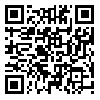Volume 11, Issue 4 (12-2023)
JoMMID 2023, 11(4): 222-225 |
Back to browse issues page
Download citation:
BibTeX | RIS | EndNote | Medlars | ProCite | Reference Manager | RefWorks
Send citation to:



BibTeX | RIS | EndNote | Medlars | ProCite | Reference Manager | RefWorks
Send citation to:
Akbarizare M. Black Goji Berry Extract as a Natural Photosensitizer for Photodynamic Inactivation of Microbial Strains: A Promising Approach. JoMMID 2023; 11 (4) :222-225
URL: http://jommid.pasteur.ac.ir/article-1-506-en.html
URL: http://jommid.pasteur.ac.ir/article-1-506-en.html
Department of Biotechnology, Iranian Research Organization for Science and Technology (IROST)
Abstract: (2714 Views)
Introduction: Antimicrobial resistance is a critical public health concern directly contributing to many deaths globally. Unearthing new protocols to tackle pathogenic microorganisms is vital. Photodynamic inactivation (PDI) is an efficient method for treating cancer and chronic microbial infections. PDI merges light with a photosensitizer to prompt the generation of reactive oxygen species and free radicals, not including O2. These molecules cause a phototoxic reaction and lead to the death of microorganisms. Recent advancements in photodynamic inactivation are focused on the exploration of natural photosensitizers. Methods: In this study, Black Goji Berry Extract (BGBE) was utilized as a photosensitizer at 50 mg/mL concentration. The incubation periods for the extract were 10 and 15 minutes, respectively. Phototoxic reactions were induced using ultraviolet (UV) light, specifically within the 315-400 nm range at an intensity of 8W, for an illumination period of 5 min. This study utilized microbial strains of Staphylococcus aureus, Candida albicans, Pseudomonas aeruginosa, and Escherichia coli as test subjects. All the strains went through treatments under these specified conditions. Results were reported after comparing controls and treatments. Results: Incubating with BGBE for 10-15 min followed by a 5-min black UV illumination induced a phototoxic reaction in bacterial strains such as S. aureus, P. aeruginosa, and E. coli. This resulted in a decrease in bacterial viability by 0.75-0.92 log10 (CFU/mL). No significant difference was observed between the effects on Gram-positive and Gram-negative strains (P>0.05). Moreover, no phototoxic reaction was observed in Candida albicans under similar conditions. Conclusion: While a sublethal photodynamic reaction was recorded in specific bacterial strains post-photodynamic inactivation utilizing BGBE, BGB exhibits potential as a natural source for innovative photosensitizers.
Keywords: Photodynamic Inactivation, Black Goji Berry, Photosensitizer, Phototoxic reaction, Microbial infection, Natural products
Type of Study: Short communication |
Subject:
Anti-microbial agents, resistance and treatment protocols
Received: 2022/11/16 | Accepted: 2023/12/10 | Published: 2024/02/24
Received: 2022/11/16 | Accepted: 2023/12/10 | Published: 2024/02/24
References
1. Sun Y, Ogawa R, Xiao B-H, Feng Y-X, Wu Y, Chen L-H, et al. Antimicrobial photodynamic therapy in skin wound healing: A systematic review of animal studies. Int Wound J. 2020; 17 (2): 285-99. [DOI:10.1111/iwj.13269] [PMID] []
2. Akbarizare M. Photodynamic Inactivation Property of Saffron (Crocus sativus) as a Natural Photosensitizer in Combination with Blue Light in Microbial Strains. Iranian J Med Microbiol. 2022; 16 (6): 585-91. [DOI:10.30699/ijmm.16.6.587]
3. Tang P, Giusti MM. Black Goji as a Potential Source of Natural Color in a Wide pH Range. Food Chem. 2018; 269: 419-26. [DOI:10.1016/j.foodchem.2018.07.034] [PMID]
4. Dong Y, Yang C, Zhong W, Shu Y, Zhang Y, Yang D. Antibacterial effect and mechanism of anthocyanin from Lycium ruthenicum Murr. Fron Microbiol. 2022; 13: 974602. [DOI:10.3389/fmicb.2022.974602] [PMID] []
5. Islam T, Yu X, Badwal TS, Xu B. Comparative studies on phenolic profiles, antioxidant capacities and carotenoid contents of red goji berry (Lycium barbarum) and black goji berry (Lycium ruthenicum). Chem Cent J. 2017; 11 (1): 59. [DOI:10.1186/s13065-017-0287-z] [PMID] []
6. Tantananugoor S, Teerakapong A, Sattayut S, Damrongrungruang T. Efficacy of erythrosine and anthocyanin mediated photodynamic therapy on Porphyromonas gingivalis biofilms using green light in vitro. The 4 International LDRG - HICU & Saraburi Hospital Symposium. 2014; p. 34-46.
7. Kashef N, Akbarizarea M, Kamrava SK. Effect of sub-lethal photodynamic inactivation on the antibiotic susceptibility and biofilm formation of clinical Staphylococcus aureus isolates. Photodiagnosis Photodyn Ther. 2013; 10 (4): 368-73. [DOI:10.1016/j.pdpdt.2013.02.005] [PMID]
8. Ghorbani J, Rahban D, Aghamiri S, Teymouri A, Bahador A. Photosensitizers in antibacterial photodynamic therapy: an overview. Laser Ther. 2018; 27 (4): 293- 302. [DOI:10.5978/islsm.27_18-RA-01] [PMID] []
9. Bohrmann-Linde C, Zeller D. Photosensitizers for Photogalvanic Cells in the Chemistry Classroom. World J Chem Edu. 2018; 6 (1): 36-42. [DOI:10.12691/wjce-6-1-7]
10. Favaro LIL, Balcão VM, Rocha LKH, Erica C. Silva a, Jr JMO, Vila MMDC, et al. Physicochemical Characterization of a Crude Anthocyanin Extract from the Fruits of Jussara (Euterpe edulis Martius): Potential for Food and Pharmaceutical Applications. J Braz Chem Soc. 2018; 29 (10): 2072-88. [DOI:10.21577/0103-5053.20180082]
11. Zonunsanga. Targeted Phototherapy (newer phototherapy). Our Dermatol Online. 2015; 6 (2): 222-7. [DOI:10.7241/ourd.20152.59]
12. Wiench R, Nowicka J, ˛aczkowska MP, Kuropka P, Skaba D, Kruczek-Kazibudzka A, et al. Influence of Incubation Time on Ortho-Toluidine Blue Mediated Antimicrobial Photodynamic Therapy Directed against Selected Candida Strains-An In Vitro Study. Int J Mol Sci. 2021; 22 (20): 10971. [DOI:10.3390/ijms222010971] [PMID] []
Send email to the article author
| Rights and permissions | |
 |
This work is licensed under a Creative Commons Attribution-NonCommercial 4.0 International License. |

This work is licensed under a Creative Commons Attribution-NonCommercial-NoDerivatives 4.0 International License.







